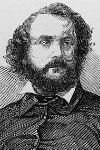 I have often written about the various experiments that have been done at the Navy Yard; this is a topic that draws me back again and again, much like the manufacturing history of the Hill on the whole does. Imagine my surprise to discover that there was an almost wholly forgotten episode that included one of the country’s most famous (or infamous?) names: Samuel Colt (pic), he of revolver fame.
I have often written about the various experiments that have been done at the Navy Yard; this is a topic that draws me back again and again, much like the manufacturing history of the Hill on the whole does. Imagine my surprise to discover that there was an almost wholly forgotten episode that included one of the country’s most famous (or infamous?) names: Samuel Colt (pic), he of revolver fame.
Fortunately, the Smithsonian published a lengthy monograph on the subject in 1974. It forms the basis of my following story.
Samuel Colt, as a young lad of 14, came up with the idea for applying explosives to the hulls of enemy ships without the use of the notoriously inaccurate cannons of the day: What if the charges were underwater, and simply were set off when a ship passed over them? Mines had been built since the Revolutionary War but did not work very well, as the mechanism needed to get them to explode was far too complicated and thus likely to fail.
Colt’s idea was to use electric currents to set off the gunpowder. Elisha K. Root, a mechanic who lived near Colt later mentioned that Colt had tested out his invention on a local pond in 1829: “I with other apprentices of the neighborhood walked some way to see the sight. An explosion was produced, but the raft was by no means blown sky-high.” In fact, others pointed out that the problem was that Colt’s “crude device erupted near rather than under the raft,” and thus felt that the whole experiment had been a failure. Nonetheless, this was Root’s introduction to Colt, and the two would remain friends for the rest of their lives.
Colt put mines on the back burner. He first went to sea and then revolutionized (no pun intended) handguns when he patented a new firearm that allowed for the shooting of multiple shots without reloading, by using a barrel filled with multiple shots that could be rotated into position in front of the barrel for firing. Unfortunately, his new invention failed to catch on immediately; thus, the inventor returned to his original idea for the destruction of life and property.

The USS North Carolina, a 74-gun ship launched in 1820. In 1842, it was parked in New York harbor, and would be scrapped some 25 years later. (Wikipedia)
Crucial to this renewed work were batteries, wires, and detonators. One of those whose expertise Colt sought out was Samuel F. B. Morse, who was working on his electrical telegraph at the time. Finally, in 1842, it was time for a test. A hulk was towed out into New York harbor and, according to the New York American (as quoted in the Niles’ National Register of July 16, 1842):
The case containing the combustibles was sunk under the hulk, and a wire conducted from it to the deck of the North Carolina, distant some to or three hundred yards. At the moment fixed, Mr. Colt, on the deck of the Carolina, applied the acid to his plates, and quicker than thought, the doomed hulk was thrown into the air.
A more poetic take, also quoted in Niles’, came from the correspondent from the New York Courier and Enquirer:
[W]ith the quickness of the electric flash the vessel was blown up, and into ten thousand fragments, which were seen amidst a column of water thrown up with them, to a height of some 120 feet, looking like a great water spout, when the whole, water and fragments fell, as does water from a jet d’eau, or fountain, though in a less regular form. The suddenness with which the vessel, which I suppose to have been of some hundred tons burden, disappeared – was more like an optical delusion than reality – for in the twinkling of an eye, the form and fashion of the boat was changed into a column of water and fragments.
Although some immediately pointed out the real problem here – that it was rare that one would be able to place the charge directly beneath a ship – the experiment was successful enough for Colt to approach Congress to request the larger sums that would be necessary to perfect his invention.
Next week: Blowing up the Anacostia.
